HubSpot Reports – All You Need to Know
HubSpot’s Reporting feature gives you valuable insights into your website’s traffic, leads, and customers. With this data, you can make informed...
By centralising all of your data in one place, HubSpot dashboards make it easy to track your progress and spot any areas that need improvement.
In today's fast-paced business world, time is money. That's why having an efficient way to track your company's progress is essential. This is where HubSpot dashboards come in.
These online tools provide users with a quick and easy way to see how their business is performing by centralising all their data in one place. HubSpot dashboards offer a wide range of benefits, including improved accuracy, better communication, and most importantly, saving time.
This article will explore the benefits of using HubSpot dashboards, different types of dashboards, and how to create them. We'll also share some tips on how to get the most out of your dashboards. So, whether you're a small business owner or a marketing professional, read on to discover how HubSpot dashboards can help you run your business more effectively.
HubSpot Dashboards are interactive visual displays of data that allow users to monitor and analyse their marketing, sales, and customer service activities. Dashboards can be designed to display data in a variety of formats, including charts, tables, and graphs, and can be filtered to show data for specific time periods, campaigns, or other variables. These features allow users to create custom dashboards that organise related reports for different reporting purposes.
HubSpot Dashboards can be used to organise related reports and can be created for different reporting purposes. For instance, if a company wants to track its social media engagement, it can create a HubSpot Dashboard that displays relevant data such as the number of social media followers, the number of likes, comments, shares, and other engagement metrics. This dashboard can be customised to show data for specific time periods or campaigns, making it easier for the company to monitor and analyse its social media performance. Similarly, HubSpot Dashboards can be created for other reporting purposes, such as monitoring website traffic, tracking email campaigns, and analysing sales data.
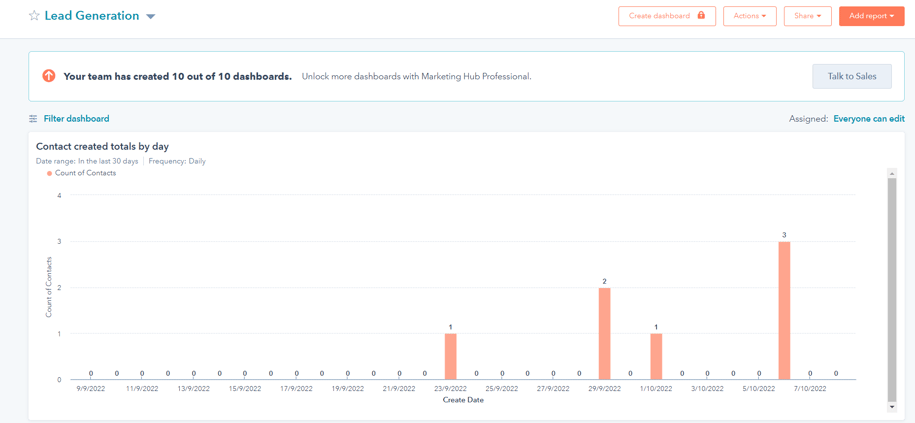
HubSpot Dashboards offer several benefits for businesses that want to gain insight into their marketing, sales, and customer service activities. Here are some of the reasons why businesses may use HubSpot Dashboards.
Save Time:
Rather than having to search through different reports to find the information you need, you can simply pull up your dashboard and see everything in one place. This can be a huge time-saver, especially if you're trying to track multiple metrics at once. Instead of having to search through various reports to find the information you're looking for, you can simply access it all from one centralised location. This level of convenience is invaluable for any busy professional.
Increase Collaboration:
Dashboards can be shared with other users within an organisation, allowing for collaboration and teamwork
Communications
Finally, HubSpot dashboards can help improve communication.
When everyone in your company is looking at the same data, it's easier to have meaningful conversations about your business's progress. Dashboards can also be a great way to share information with investors or other stakeholders.
Monitor and analyse key metrics:
HubSpot Dashboards provide users with real-time data and insights into their marketing, sales, and customer service activities, allowing them to monitor and analyse key metrics and performance indicators
Data visualisation:
Data can be displayed in a variety of visual formats, including charts, tables, and graphs, making it easier for users to understand and interpret the data
Integration with other tools:
HubSpot Dashboards can be integrated with other HubSpot tools, as well as third-party applications, allowing users to view data from multiple sources in one place.
Customisable by department:
Dashboards can be customised to meet the specific needs of individual users or organisations. Users can choose from a variety of pre-built dashboard templates or create their own custom dashboards using a drag-and-drop interface
Improve Accuracy:
Another benefit of HubSpot dashboards is that they improve accuracy.
When information is spread out across different HubSpot reports, it's easy to make mistakes when trying to put all of the pieces together. By centralising your data in one place, HubSpot dashboards help ensure that you're looking at accurate information. This can be vital when making decisions about your business.
Improve Efficiency:
HubSpot dashboards improve efficiency by allowing you to quickly spot any areas that need improvement.
Make Better Decisions:
HubSpot dashboards provide you with the information you need to make better decisions about your business. When you have all of your data organised and accessible, you're able to make better decisions about your business. With HubSpot dashboards, you can quickly identify any problems or areas of opportunity so that you can take action accordingly. This real-time insight is essential for any business that wants to stay ahead of the competition.
Stay Organised:
HubSpot dashboards help you stay organised by allowing you to share dashboards with other users in your account and clone or delete existing dashboards. One of the biggest advantages of HubSpot dashboards is that they help you stay organised. With all of your data in one place, you can easily track your progress and identify any areas that need improvement. This level of organisation is essential for any business that wants to operate efficiently.
Save Money:
HubSpot dashboards can save you money by eliminating the need for expensive data-gathering software.
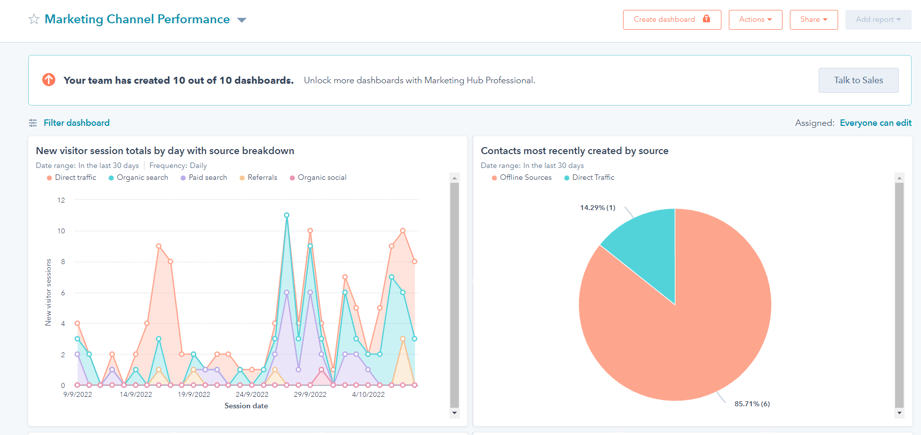
1. HubSpot Sales Dashboards:
The HubSpot Sales Dashboard gives users an overview of their sales pipeline. This dashboard includes information such as the number of leads, the number of deals in each stage, and the value of each HubSpot deal. The Sales Dashboard displays key sales metrics, such as deals closed, revenue generated, and sales pipeline growth. It helps sales teams track their performance and identify areas for improvement.
2. HubSpot Marketing Dashboards:
The HubSpot Marketing Dashboard gives users an overview of their marketing efforts. This dashboard includes information such as website traffic, social media engagement, and email open rates. The Marketing Dashboard provides an overview of key marketing metrics, including website traffic, leads, conversions, and customer acquisition cost. It helps marketers track the performance of their campaigns and make data-driven decisions to improve their marketing strategies.
3. HubSpot Service Dashboards:
The HubSpot Service Dashboard gives users an overview of their customer service efforts. This dashboard includes information such as the number of support tickets, the average resolution time, and the customer satisfaction score. The Service Dashboard provides insights into customer service activities, including customer satisfaction rates, response times, and ticket volume. It helps customer service teams identify trends and areas for improvement in their service delivery.
4. HubSpot Custom Dashboards:
HubSpot Custom Dashboards allow users to create their own dashboards. This feature is perfect for businesses that want to track specific data sets that are not available in the pre-built dashboards.
5. And More like:
Web Analytics Dashboard: The Web Analytics Dashboard displays website traffic data, including visitor demographics, behaviour, and traffic sources. It helps businesses understand their website's performance and optimise their online presence.
Social Media Dashboard: The Social Media Dashboard displays social media engagement metrics, including likes, comments, shares, and followers. It helps businesses track their social media performance and identify opportunities for growth.
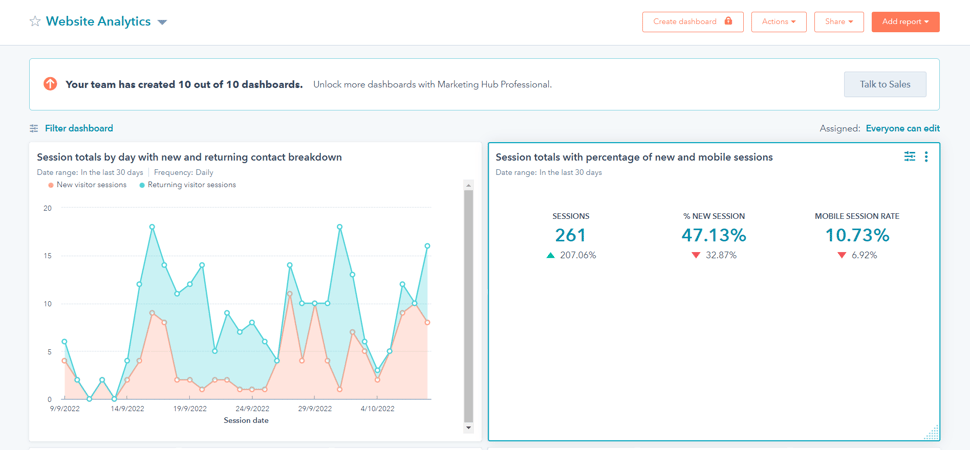
Creating a HubSpot dashboard is quick and easy. Simply log into your account and click on the "Dashboards" tab. From there, you'll be able to create new dashboards or clone existing ones. Once you've created your dashboard, you can add reports by clicking on the "Add Reports" button. You can also rearrange the order of your reports by dragging and dropping them into place.
If you're not sure which reports to include on your dashboard, HubSpot offers a variety of pre-built reports. These reports cover a range of topics, including HubSpot social media, website traffic, lead generation, and sales. Including a mix of reports on your dashboard will help you get a well-rounded view of your business's progress.
Once you've created your dashboard, you can share it with other users in your account by clicking on the "Share" button. You can also export your dashboard as an image or PDF file.
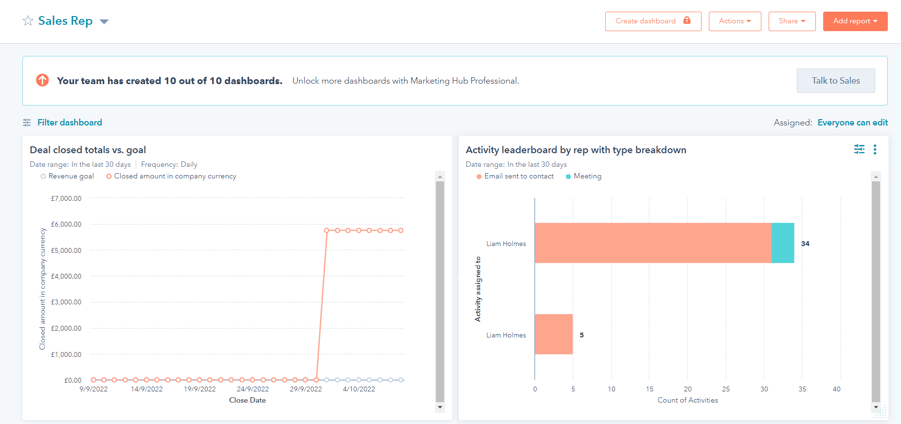
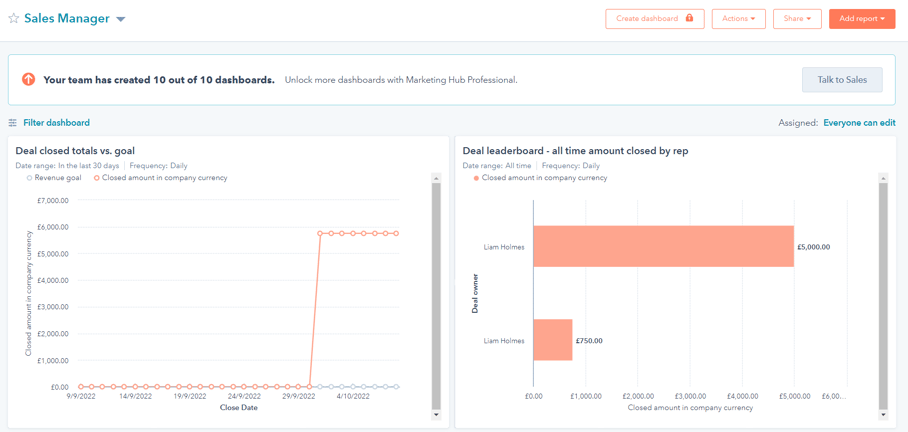
1. Use filters to narrow down your data:
When you're looking at a dashboard, you can use filters to only include the data that's relevant to you. This is a great way to get a more focused view of your data.
2. Use multiple dashboards to track different data sets:
If you're tracking multiple data sets, it's a good idea to create separate dashboards for each one. This will help you stay organised and make it easier to find the information you're looking for.
3. Use custom reports to track specific metrics:
If there's a specific metric you want to track, you can create a custom report for it. This report will then be available on all of your dashboards.
4. Use the " cloning" feature to create similar dashboards:
If you want to create a dashboard that's similar to an existing one, you can use the "clone" feature. This will save you time and ensure that your new dashboard is identical to your old one.
5. Use the " sharing" feature to share your dashboards with others:
If you want to share your dashboards with other users, you can use the "share" feature. This allows you to give a view or edit access to your dashboard.
HubSpot Dashboards are interactive visual displays of data that provide businesses with valuable insights into their marketing, sales, and customer service activities. Dashboards can be customised to meet the specific needs of individual users or organisations, and data can be displayed in a variety of visual formats, including charts, tables, and graphs. HubSpot Dashboards offer a range of features, including real-time data updates, integration with other HubSpot tools and third-party applications, and collaboration. These features enable businesses to gain insight into their performance, identify areas for improvement, and make data-driven decisions. Overall, HubSpot Dashboards are a valuable tool for businesses of all sizes that want to streamline their workflows, work smarter, and leverage the power of data for growth and success.
HubSpot dashboards are powerful tools that can save you time and improve the accuracy of your data. By centralising all of your company's information in one place, HubSpot dashboards make it easy to track your progress and spot any areas that need improvement. If you're not already using HubSpot dashboards, we recommend giving them a try. You might just find that they revolutionise the way you do business.
HubSpot’s Reporting feature gives you valuable insights into your website’s traffic, leads, and customers. With this data, you can make informed...
HubSpot Analytics is a data-driven marketing and sales platform that provides users with powerful marketing, sales, and service reporting.
Integrating your WordPress website with HubSpot is a no-brainer. It is quick and easy, letting you harness the power of a unified website & CRM
Be the first to know about new HubSpot nsights to build or refine your business with the tools and knowledge of today’s best practises.